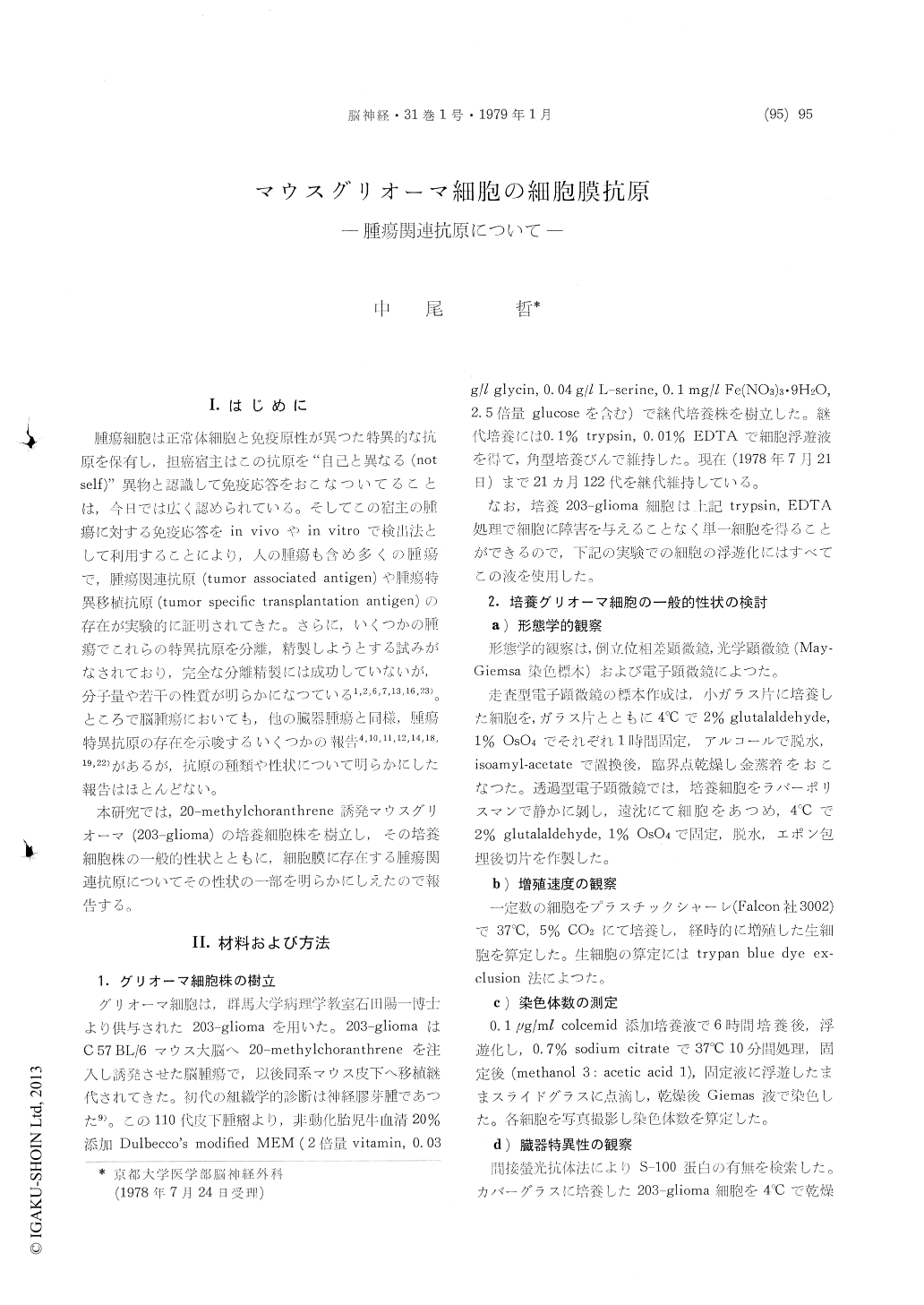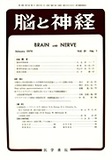Japanese
English
- 有料閲覧
- Abstract 文献概要
- 1ページ目 Look Inside
I.はじめに
腫瘍細胞は正常体細胞と免疫原性が異つた特異的な抗原を保有し,担癌宿主はこの抗原を"自己と異なる(not self)"異物と認識して免疫応答をおこなついてることは,今日では広く認められている。そしてこの宿主の腫瘍に対する免疫応答をin vivoやin vitroで検出法として利用することにより,人の腫瘍も含め多くの腫瘍で,腫瘍関連抗原(tumor associated antigen)や腫瘍特異移植抗原(tumor specific transplantation antigen)の存在が実験的に証明されてきた。さらに,いくつかの腫瘍でこれらの特異抗原を分離,精製しようとする試みがなされており,完全な分離精製には成功していないが,分子量や若干の性質が明らかになつている1,2,6,7,13,16,23)。ところで脳腫瘍においても,他の臓器腫瘍と同様,腫瘍特異抗原の存在を示唆するいくつかの報告4,10,11,12,14,18,19,22)があるが,抗原の種類や性状について明らかにした報告はほとんどない。
本研究では,20—methylchoranthrene誘発マウスグリオーマ(203—glioma)の培養細胞株を樹立し,その培養細胞株の一般的性状とともに,細胞膜に存在する腫瘍関連抗原についてその性状の一部を明らかにしえたので報告する。
Cultured murine glioma cell line was established from the transplantable tumor which was induced by the injection of 20-methycholanthrene to the cerebrum of adult C57BL/6 mouse (Kawarai, 1969) and was serially transplanted to syngeneic C57BL/ 6 mice subcutaneously. The cells were begun in monolayer tissue culture using modified Eagel's MEM (a two-fold concentration of vitamins and aminoacids, 0.03 g/l glycin, 0.04 g/l L-serine, 0.1 mg/l Fe (NO3) 39H2O, and a 2.5-fold glucose) sup-plemented with 20% heat inactivated fetal calfserum, and were passaged every 4 to 10 days by the treatment of 0.1% trypsin and 0.01% EDTA. Cultured 203-glioma cells had characteristics of murine glioma such as morphological findings (large cells with multi-polar processes) observed by phasecontrast microscopy and scanning electron microscopy, the presence of intracellular glial filaments (about 80 Å in diameter) showed by electron microscopy, and also the presence of brain specific protein, S-100 protein, in cytoplasmas evidenced by indirect immunofluoresence. Doubling time of cultured 203-glioma cells was about 50 hours (11th passage) and about 24 hours (90th passage), and saturation density was about 2×105 cells/cm2. Mode of chromosome numbers was 60 (6th passage) and 57 (88th passage), and at least five types of marker chromosomes were observed.
As already reported by us, cultured 203-glioma cells possess tumor specific antigen (s) as tumor specific killer T lymphocytes appeared in lymphnodes and spleens of 203-glioma bearing syngeneic C57BL/6 mice evidenced by the methods of micro-cytotoxicity assay and adoptive transfer test (Nakao et al., 1978). Surface tumor associated antigens of 203-glioma cells were partially characterized in this paper.
Surface proteins of 203-glioma cell membranes were radiolabeled with 125I by lactoperoxidase, were solubilized by 0.1% Nonidet P 40, and were in-vestigated by SDS polyacrylamide gel electro-phoresis. Surface proteins of 203-glioma cells consisted of eleven components and were different from these of murine erythrocytes, thymocytes and M-1 cells (macropage cell line). Radioiodinated 203-glioma cell lysates were precipitated secifically with antisera obtained from syngeneic C57BL/6 mice that were immunized with mitomycin C treated 203-glioma cells repeatedly, or were inocu-lated 106 viable 203-glioma cells 7 weeks before. Precipitates of cell membrane components by syngeneic antisera were thought to be tumor as-sociated antigens and were fractionated by sephadex G-200 gel chromatography and SDS polyacrylamide gel electrophoresis. The experiments suggested that surface tumor associated antigens of 203-glioma cells consisted of at least five kinds of molecules. The molecular weight of these proteins were estimated to be 170,000, 140,000-145,000, 105,000-118,000, 62,000, and 44,000 daltons respectively.

Copyright © 1979, Igaku-Shoin Ltd. All rights reserved.


